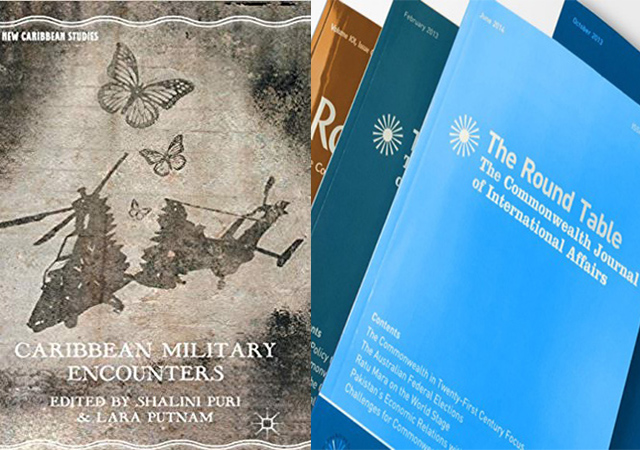
[This is an excerpt from a book review appearing in the current editionf of The Round Table: The Commonwealth Journal of International Affairs]
As an international relations scholar the military interventions in the Caribbean during the course of the twentieth century are well known to me. The role of the United States is of course key; defined in large part by the Roosevelt Corollary of 1904, which stipulated that the US exercise ‘international police power’ to preserve stability in the Western hemisphere. What then resulted were US occupations in Cuba, the Dominican Republic and Haiti; the latter lasting from 1915 to 1934. After the Second World War, the US role became more covert, although notable exceptions included the interventions in the Dominican Republic (1965–1966), Grenada (1983), and Haiti (1994). One of several noteworthy aspects of Caribbean Military Encounters is that many lesser known examples of ‘militarization’ are detailed. So, for example, there is consideration of: Britain’s military presence in the region (Operation Sheepskin in Anguilla, 1969); the role of protest and sometimes accommodation in relation to US military bases in Guantánamo and Vieques; and Cuban narratives of the war in Angola. Indeed, as the focus of these chapters suggests, the book moves away from the social sciences and security-studies to ‘scholarship [looking] at the actual negotiations by people on the ground of the experience of militarization’.
The collection contains 17 contributions using a range of disciplines and genres, from literary and cultural studies to ethnography, and from musicology to personal narrative. A single chapter by Jenny Matthews entitled ‘In “the back yard”: experiences of war in the Greater Caribbean’ is a photo essay, which offers an effective and often affecting visual account of the daily experience of military conflict. One of the most interesting photos is that of a partially defaced poster produced by the US military during the invasion of Grenada, showing Bernard Coard and Hudson Austin (two key members of the revolution) under arrest. However, my focus on political and military leaders here does not really do justice to much of the focus of the volume. As the editors say, ‘… this anthology [focuses] less on the relatively obvious opportunism and power bids of local and foreign elites and more on the calculations and constraints of disenfranchised people whose lives, beliefs and limited choices are intertwined with the military’. It does this very successfully by focusing on two broad aspects of militarization. First, the impact of defined military acts or interventions, either directly in the region or involving its citizens elsewhere, and second, the effects and responses to more embedded and longer-standing military abuses. I cannot do justice to every chapter, but I can provide a snapshot of some of them, and the ‘encounters’ that are revealed.
In regard to the impact of defined military acts or interventions, I was particularly drawn to the chapter by Grace L. Sanders, who examines how the US occupation of Haiti transformed its public space and infrastructure. She highlights the disjuncture between the new roads and walkways built using forced labour that were used by the military to establish and maintain its control, but which were also used as sites to challenge the US presence. She is especially interested in how women ‘negotiated’ these public spaces. As Sanders argues, ‘… [they] shaped Haitian women’s lives and livelihoods, placing them in the path of violent occupiers while also allowing them to subvert their local hierarchies in new ways’. Another chapter that caught my eye was written by Marisabel Almer on ‘Cuban narratives of war: memories of Angola’. Cuba’s role in Angola, which involved over 400,000 Cubans between 1975 and 1991, was once a central feature in its revolutionary discourse, but now, as Almer argues, ‘has largely receded from public memory’. In response, she is keen to explore the memories that remain using official narratives, narratives of combatants, and those of non-combatant Cubans, and what is revealed is an interesting and sometimes dissonant mixture of ‘resentment, racism, solidarity, and nationalist pride’. Finally, there is the chapter by John C. Nelson entitled ‘A “parvenu predator”? When the kill zone and the contact zone collide on the Isle of Spice’. Nelson provides an engaging first-person account of his participation as a 19-year-old combatant in the US invasion of Grenada. He uses the work of such writers as Derek Walcott, Merle Collins, V.S. Naipaul and Gus John to frame and contextualize his experiences. He also argues that those who were directly involved in the implosion of the revolution, such as Bernard Coard, should finally tell the truth of what took place. He quotes John, who wrote, ‘After twenty seven years, it is time to tell’.
This provides a segue into a brief appraisal of the account of the Grenada Revolution by Bernard Coard, who was deputy prime minister during this period. Coard was a key figure in trying to establish a joint leadership with Prime Minister Maurice Bishop in 1983. As Gary Williams and I wrote previously in this journal, ‘Coard was the unpopular hard-core ideologue to whom the public had never warmed’, and when the revolutionary leadership fractured Bishop was supported by the people. The final act was the murder of Bishop and seven colleagues, along with a number of his supporters. This precipitated the US invasion, and the later imprisonment of Coard and several others after being convicted of the killings. Of those key events there is nothing new from Coard. He repeats the claim made elsewhere that he ‘bears the overwhelming responsibility for what happened’, but he and others holding the leadership at that time did not order the killings. Indeed, Coard recalls that events moved so rapidly and unexpectedly that they were in a ‘collective daze’.
Peter Clegg is with the University of the West of England.



